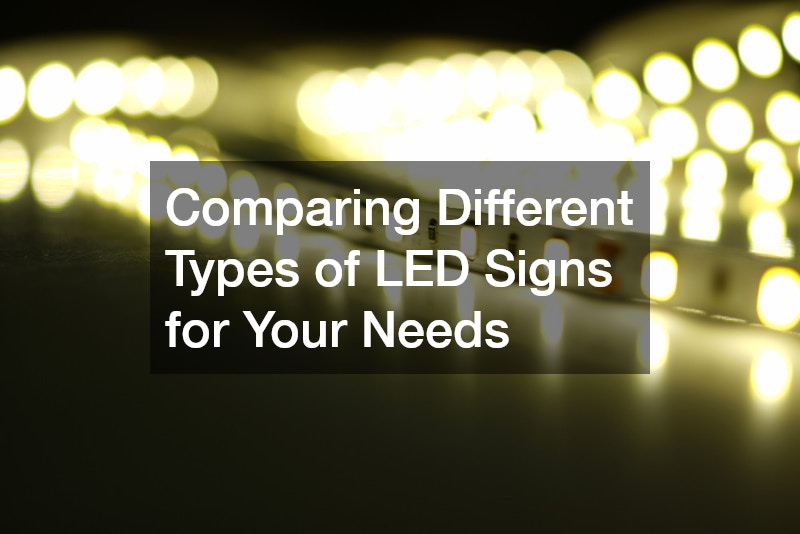This article explores various types of LED signs available in the market, guiding you through their features, benefits, and ideal use cases to help you make informed decisions for your needs. LED signs have become increasingly popular for businesses, schools, and organizations because of their bright displays, energy efficiency, and long lifespan. From programmable message boards to full-color digital displays, each type of LED sign serves a unique purpose, whether you want to advertise promotions, provide real-time information, or enhance visibility from a distance.
Understanding the differences between indoor and outdoor signs, as well as options for size, resolution, and control systems, ensures that you choose the most effective solution for your goals. By knowing what to look for, you can maximize the impact of your investment and create an eye-catching, durable display.
What Are the Different Types of LED Signs Available?
Single-color LED signs are designed to display only one hue, which makes them suitable for straightforward messaging, such as open/closed signs or simple advertisements. They are often less expensive than their multi-color counterparts and can still convey important information effectively.
Dual-color LED signs allow businesses to display messages in two different colors, enhancing visual appeal and versatility. These signs are commonly used for conveying more complex information while maintaining simplicity and ease of readability, making them a great choice for restaurants or cafes.
Full-color LED displays are the most advanced option, capable of showcasing vibrant images and videos in a wide spectrum of colors. These signs are ideal for larger businesses or high-traffic areas where dynamic advertising can capture attention and engage customers in a memorable way.
How Do LED Signs Compare to Traditional Signs?
When it comes to visibility, LED signs have a significant advantage over traditional signs, particularly in low-light conditions. Their brightness ensures that messages are seen from a greater distance, which can lead to increased foot traffic and customer engagement.
Energy efficiency is another crucial area where LED signs outshine traditional signage. LED technology uses less power compared to neon or incandescent lights, leading to lower energy bills and a reduced environmental impact. Businesses can save money while promoting sustainability by choosing LED options.
Maintenance is yet another factor that favors LED signs. Unlike traditional signs, which may require regular bulb replacements and upkeep, LED lights have a longer lifespan and lower upkeep costs. This convenience allows business owners to focus more on their operations rather than spending time and money on sign maintenance.
What Factors Should You Consider When Choosing an LED Sign?
The size of your LED sign is crucial. A larger sign can attract more attention, especially in busy commercial areas, but it must also fit seamlessly within your business’s aesthetic. Evaluating the space available for your sign is essential to ensure it complements your location.
Location plays a major role in how effective an LED sign will be. Consider whether the sign will be placed indoors or outdoors, as different environments may require different types and levels of brightness. Additionally, high-traffic areas will benefit from signs that can be seen easily from a distance.
Brightness and design are equally significant. The brightness of your LED sign should adhere to local regulations while ensuring visibility day and night. Furthermore, the design should reflect your brand identity, using colors and fonts that communicate your message effectively while appealing to your target audience.
What Are the Benefits of Using LED Signs for Businesses?
LED signs are known for their cost-effectiveness, particularly in terms of energy savings over time. The initial investment, while potentially higher than other sign types, pays off due to lower power consumption and reduced maintenance costs. This affordability makes LED signs a smart financial choice for businesses.
The versatility of LED signs allows businesses to update messages and images quickly and easily. Digital slideshows can be displayed, showcasing promotions or events, which keeps content fresh and engaging without the costs associated with traditional sign changes.
Lastly, LED signs have proven to attract customers more effectively than traditional signage methods. Their dynamic displays can draw attention, particularly in busy retail environments, significantly enhancing foot traffic and customer interaction. Companies that utilize LED signage often report increased sales as a direct result of higher visibility.
Selecting the right type of LED sign can significantly impact your business visibility and customer engagement. By understanding the various options and their advantages, you can make a choice that fits your needs best. LED signs are not only visually striking but also energy-efficient and versatile, offering the ability to update messages quickly and attract attention at all hours. Whether you are considering an indoor display for informational purposes or a large outdoor sign to promote your brand, knowing the differences in size, resolution, and display capabilities will help you maximize effectiveness. Investing in the right LED sign ensures long-term value, improved communication with your audience, and a professional, modern appearance that reinforces your brand identity.

